As we have researched animals and breeds for the farm, we found ourselves having a preference for heritage breeds – breeds that do well living free range and able to forage for much of their food. Among our animal kingdom, we have Narangansett turkeys, rare Black Copper Maran chickens that lay rich chocolate colored eggs, Large Black Hogs, llamas, goats, sheep, horses and Tibetan yaks.
Tibetan Yaks
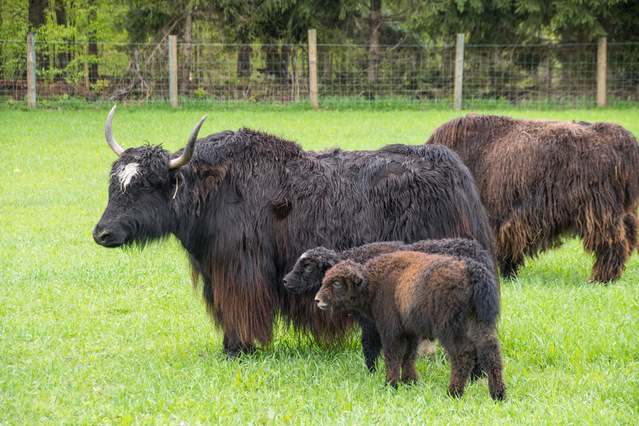
So what’s a yak? Yaks are native to Tibet and are most comparative to Bison, just a lot smaller. Their meat is lean, just like bison, and they take longer to grow. Yaks have not been messed with in terms of genetics. A yak today is pretty much the same yak as you would find 10,000 years ago. They are more efficient with both food and water than cattle, and their soft fiber is shed each year and turned into socks, mittens, coats and hats.
Large Black Hogs
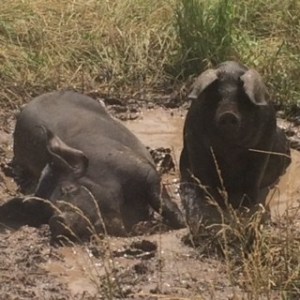
We started raising Large Black Hogs in the spring of 2015 and we love them. They are so easy going and playful, even mischievous!
These hogs are an endangered breed with only around 2100 registered hogs in the US. The irony is that they used to be the hog of choice prior to “factory farming”. While they were ideal as pasture pigs, they fell out of favor when hogs were moved into barns with concrete floors, causing them to go lame.
Our pigs live out on the pasture, grazing, rooting and playing in their mud hole.
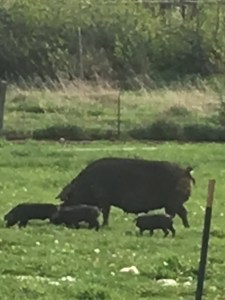
Pastured Large Black Hog pork is nothing like grocery store pork. This pork is micro-marbled and pink, not white. The texture is extra tender and pasturing outdoors adds loads of omega 3’s and vitamin D. This unique characteristic of the meat has earned a place in some of the most exclusive restaurants in New York and Europe looking for an old world flavor. Heard of the famous Spanish hogs that eat the acorns every year to produce the best pork in the world? These are their cousins. Oh yes, and don’t forget the bacon – the long length of these hogs means extra bacon!
Angus Charolais Cows
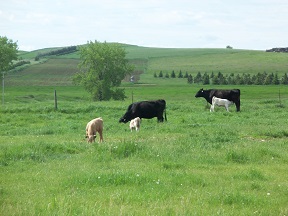
Our daughter Stephanie and her husband Rick raise our cows for us on 4000 acres of pastureland a few hours north of us. Our herds spend 2 summers grazing on these lush pastures of the Grand River Grasslands. During winter, they are brought in to closer pastures and fed a variety of grasses and plants harvested over summer.
To avoid the use of GMO corn, the old world standard of barley is used for finishing just prior to harvest. Approximately 30-45 days before slaughter, we supplement their feed with barley to get the marbling of fat and the flavor just right. Once harvested, we age the meat for 3 weeks, ensuring peak flavor and tenderness in every cut.
Our Angus/Charolais cross create a unique a breed particularly suited to this pastured life in the Dakota climate that offers a lean, well marbled cut of beef, superior to straight Angus. But don’t take our word for it, take some home and see for yourself!
Laying Hens
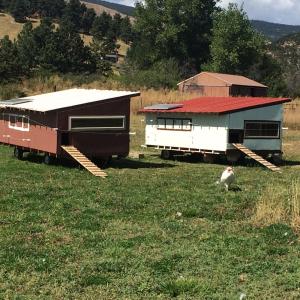
We raise all our laying hens on our pasture. They lay and spend the night in the “chicken tractor” that we move around to encourage grazing in different areas. Each tractor has solar panels and a battery to operate the automatic door, light, and water pump. To keep the predators out at night, we have a hot wire (also solar powered) that surrounds each tractor. We have over 10 varieties of egg layers that give us an Easter basket of colorful eggs each day.
Did You Know? Farmers have 30 days from the day an egg is laid to get it to stores. Then, the stores have another 30 days to sell the eggs. On Valentines Day, you could be eating an egg that was laid on Christmas!
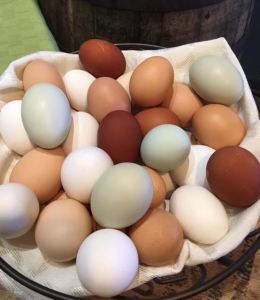
Why pastured eggs? Compared to USDA nutrient data for commercial eggs, eggs from hens raised on pasture contain up to:
- 1/3 less cholesterol
- 1/4 less saturated fat
- 2/3 more vitamin A
- 2x more omega-3’s
- 3x more Vitmain E
- 7x more beta carotene
Meat Chickens
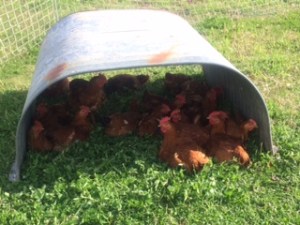
Our meat birds (broilers) arrive as day old chicks and live in our brooder house for the first 4-6 weeks, depending on weather. Once they have fully feathered out, we move them outside to pasture pens. Each pen has a door we open in the day to let the birds out to get fresh grass and bugs every day.
The breeds we raise is are Cornish Cross and Freedom Ranger. We modify the feed levels to make sure these birds do not produce the “monster” breast meat. Rather they are well proportioned and our CSA members report that they are much richer tasting than store bought chicken (we think so too).
Turkeys
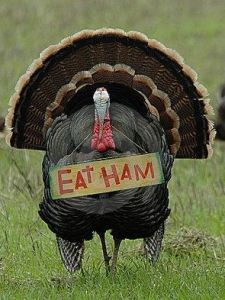
After a little yakking, let’s talk turkey! We wanted a turkey that still had the genetics and instincts to forage and breed. The Narragansett turkey seemed to be the perfect choice. This heritage breed is a medium sized bird and very social; also on the “watch list” for endangered breeds.
Goats
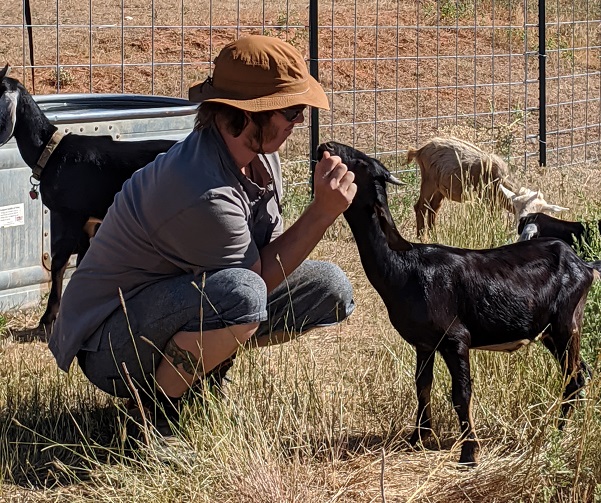
Our lawn care team consist of Luna and Billy. They mow and fertilize the lawns around the farmhouse in summer and in winter, graze problem areas in our pastures.
Llamas
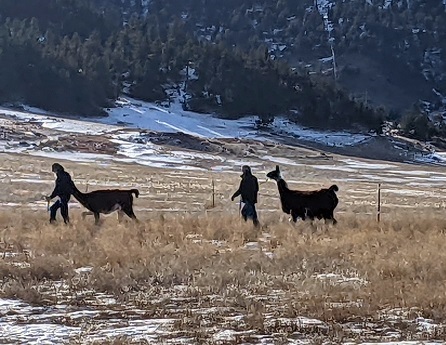
Our two llamas could not be more different. Blizzard is sassy and always looks at you with suspicion. Lilly on the other hand, is much more social and will want to smell your breath to decide if you are “ok” to be around. Their jobs on the farm are to keep coyotes away (they will alarm and chase them) and to make fertilizer. Yes, we have them for their “black gold”. Llama poo is one of the highest N-P-K content animal fertilizers and llamas deposit it in neat piles in just a few places in the pasture. This allows for easy collection. Once dry, we run it through a wood chipper/shredder to make a nice powder which is applied to our crop fields and trees in the greenhouse.
Horses
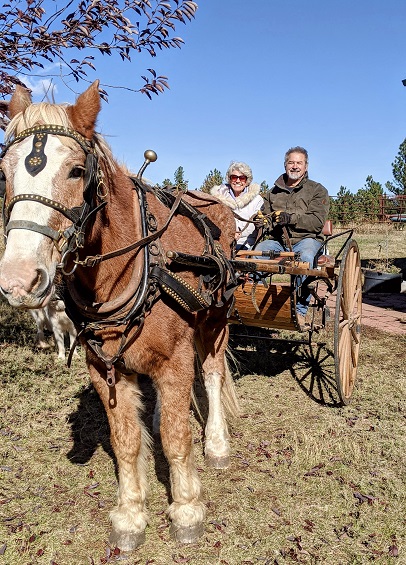
Our horses, Bonnie and Clyde have farm jobs as well. Clyde is our draft horse. He pulls carts, wagons and farm implements. Bonnie is our cutting horse and is still in training. Young and frisky, she still needs some discipline and guidance in learning her duties.
Bees

With all of our trees, crops and fields, we need pollinators! So, of course, we have bees. We grew from 4 hives to 6 hives last year and are keeping our fingers crossed that they all make it through winter.